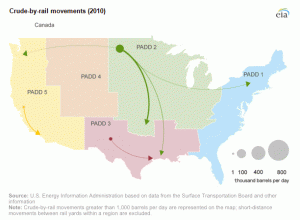Ever since Japan built the first high-speed rail line in the world linking Tokyo to Osaka in 1964, U.S. train advocates have been lobbying for true high-speed rail in the U.S. While France, Germany, Spain and recently China have built high-speed rail systems, the U.S. has resisted for many reasons. High-speed rail works most effectively transporting customers between dense city centers with robust transit systems and low rates of car ownership. A popular existing passenger rail system and higher costs of car ownership are important factors as well.
The U.S. has never fared particularly well in these categories for a number of reasons. First of all, car ownership in U.S. cities was far higher in the 1970’s than in Europe or Japan due to a more robust roadway network. In addition, U.S. cities are generally less dense than European cities. And U.S. city transit networks are much more skeletal making them less effective. Also U.S. taxes on gasoline are much lower making car travel cheaper than in Europe and Japan. Furthermore, U.S. rail tracks are dedicated to freight, creating the most efficient freight rail network in the world but limiting options for passenger rail.
Despite these challenges, in 2009, President Obama promised a national high-speed rail network. However, six years later that promise is nothing but a dream. The Obama administration strategy was flawed from the start. Instead of focusing on the most fiscally realistic place to build HSR, such as the northeast corridor, President Obama disbursed money to 38 states to build new rail but also to upgrade existing rail. The only high-speed rail project to begin construction is the California line from Los Angeles to San Francisco by way of the Central Valley. However, this project has a more than $50 billion funding hole, takes a circuitous route through the Central Valley making it physically impossible for the train to meet its travel time obligations, and is causing politicians to bend environmental review and ballot question intent laws. The project has no Republican support and is rapidly losing support from Democrats including the Lieutenant Governor. Most expect the project to be cancelled as soon as its major supporter, Jerry Brown, leaves office. High-speed rail’s track record in the U.S. has been one of almost complete failure.
All of these factors make potential high-speed rail success in the U.S. look doubtful at best.
However, there are several potential bright spots. The higher-speed Acela train operated by Amtrak on the northeast corridor has been a modest success. Train farebox revenue covers the full operating costs of the line. Many experts have speculated that a true 200-mile per hour high speed rail line would be even more successful financially. If this train could be operated by the private sector with competent management, which Amtrak has seldom provided, and be free of government restrictions such as Buy America, it might work. And if the private operator sought advice from successful rail operators in Japan instead of from the bungling bureaucrats advising the California and national rail lines, significant profits could be possible.
Two such lines are on the drawing boards. One is proposed for Florida linking Miami with Orlando International Airport. The other is proposed for Texas linking Dallas and Houston.
Let’s examine the Texas route from Dallas to Houston in a little more detail. The Texas line shares several characteristics with successful European and Japanese lines. Dallas to Houston is a popular air route, flown by three of the four largest airlines. Instead of trying to position the line in the middle of the highway or use existing tracks, the company is planning to build the line along a utility corridor. In addition to providing a dedicated right of way, such an alignment limits the number of folks living in the train’s path as people do not live in utility right of ways. The 250-mile flat distance between the two cities is perfect for high-speed rail. Finally, the metro areas each having more than 6 million folks are plenty big enough to serve as the endpoints.
However, there are several obstacles to the route as well. Neither metro area has an extensive transit system, nor the density to create such a system, so the train stations would have to feature many parking spaces. This is different from European or Japanese HSR. And whether folks living in the expansive suburbs especially near an airport would drive to the center city to take the train, versus drive to the airport is an open question. In both metro areas there are folks living in the train’s path. Living next to an Interstate highway is unpleasant; living next to a train would be unfeasible. The full cost of relocation would have to be offered to many homeowners, increasing the cost and opposition.
The biggest challenge is whether or not the system would need government funding. Texas Central Railway insists it does not. Regardless, since competitor modes, namely aviation and intercity bus are not subsidized, we should not be subsidizing HSR either.
The Texas high-speed rail proposal is intriguing. Proposed as a private operation with funding and guidance from Central Japan Railway Company the proposal is already far more promising than any of the Obama Administration’s previous lines. Nobody knows if such a private line can succeed, but Texas Central Railway certainly deserves a chance to try.
